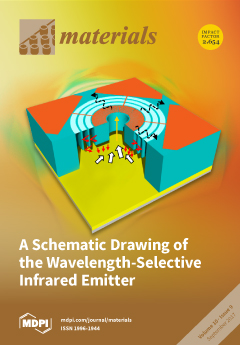Open AccessArticle
Large Electrocaloric Effect in Lead-Free (Ba0.85Ca0.15)(Zr0.1Ti0.9)O3 Ceramics Prepared via Citrate Route
by
Jing Shi 1,2, Rongfeng Zhu 1, Xing Liu 3, Bijun Fang 1,*, Ningyi Yuan 1, Jianning Ding 1,4,* and Haosu Luo 5,*
1
School of Materials Science and Engineering, Jiangsu Collaborative Innovation Center of Photovolatic Science and Engineering, Jiangsu Province Cultivation Base for State Key Laboratory of Photovoltaic Science and Technology, National Experimental Demonstration Center for Materials Science and Engineering, Changzhou University, Changzhou 213164, China
2
Institute of Electronic and Electrical, Changzhou College of Information Technology, Changzhou 213164, China
3
School of Materials Science and Engineering, Tongji University, Shanghai 201804, China
4
School of Material Science and Engineering, Jiangsu University, Zhenjiang 212013, China
5
Key Laboratory of Inorganic Function Material and Device, Chinese Academy of Sciences, Shanghai 201800, China
Cited by 34 | Viewed by 5779
Abstract
The 1 wt % Li-doped (Ba
0.85Ca
0.15)(Zr
0.1Ti
0.9)O
3 (BCZT-Li) ceramics prepared by the citrate method exhibit improved phase purity, densification and electrical properties, which provide prospective possibility to develop high-performance electrocaloric materials. The electrocaloric effect was
[...] Read more.
The 1 wt % Li-doped (Ba
0.85Ca
0.15)(Zr
0.1Ti
0.9)O
3 (BCZT-Li) ceramics prepared by the citrate method exhibit improved phase purity, densification and electrical properties, which provide prospective possibility to develop high-performance electrocaloric materials. The electrocaloric effect was evaluated by phenomenological method, and the BCZT-Li ceramics present large electrocaloric temperature change ∆
T, especially large electrocaloric responsibility
ξ = ∆
Tmax/∆
Emax, which can be comparable to the largest values reported in the lead-free piezoelectric ceramics. The excellent electrocaloric effect is considered as correlating with the coexistence of polymorphic ferroelectric phases, which are detected by the Raman spectroscopy. The large
ξ value accompanied by decreased Curie temperature (around 73 °C) of the BCZT-Li ceramics prepared by the citrate method presents potential applications as the next-generation solid-state cooling devices.
Full article
►▼
Show Figures






